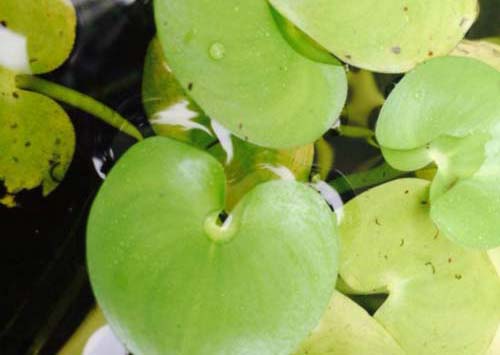Frog's Bit
Mature frog's bit (Limnobium spongia) plants provide perfect cover for bass to ambush their prey. Flip a bait close to the stems of frog’s bit and hold on.

Seasonal Techniques
Spring—Frog’s bit will likely go unnoticed in spring as the perennial grows back from overwintering buds, floating to the water surface to sprout new growth. Frog’s bit won’t be easily found until summer, so targeting this species should be avoided until summer.
Summer—Like most other aquatic plants, frog’s bit will rapidly grow during summer and become much more noticeable both floating and rooted to nearshore areas. Mature plants provide perfect cover for bass to ambush their prey. Flip a bait close to the stems of frog’s bit and hold on. Mature plants will also send off runners, so fishing a bait on the bottom around mature plants can also yield bites as bass congregate around these structures.
Fall—Frog’s bit will begin to decay as the water cools, making for the perfect opportunity to fish areas that were previously too grown up to fish. Work a weedless topwater like a frog across and through decaying plants.
Winter—Frog’s bit will be completely gone by winter throughout most of the valley, so targeting this species should be avoided until the following growing season.
Habitat Value
Fish—Submersed portions (root mass) provides habitat for invertebrates that are subsequently eaten by fish. Frog’s bit can also provide ambush cover for bass when floating.
Waterfowl—Submersed portions (root mass) provides habitat for invertebrates that are subsequently eaten by waterfowl. Seeds are also readily consumed by waterfowl.
Identifying Features
What It Looks Like—Frog’s bit is a small, often free floating plant with small kidney- or heart-shaped leaves. Leaves will have elongated stems which occur in clumps, giving frog’s bit a “bouquet” look.
Where to Find It—Can be found floating or rooted closely to the shoreline.
Similar Species—Frog’s bit may resemble water hyacinth; however frog’s bit lacks the bulbous stem of water hyacinth. Water hyacinth roots are usually purple tinged whereas frog’s bit roots are white. Frog’s bit can also resemble fragrant water lily; however fragrant water lily has a distinct “v” notch in the leaf.
Drawbacks
Although native, frog’s bit can become a nuisance given the right growing conditions, and thus sometimes requires management. Cost to manage: $$$ out of $$$$$.
Contact Us
We're always looking for more information about aquatic plants on TVA reservoirs. Let us know where and what you see, and send us your photos. Email us.